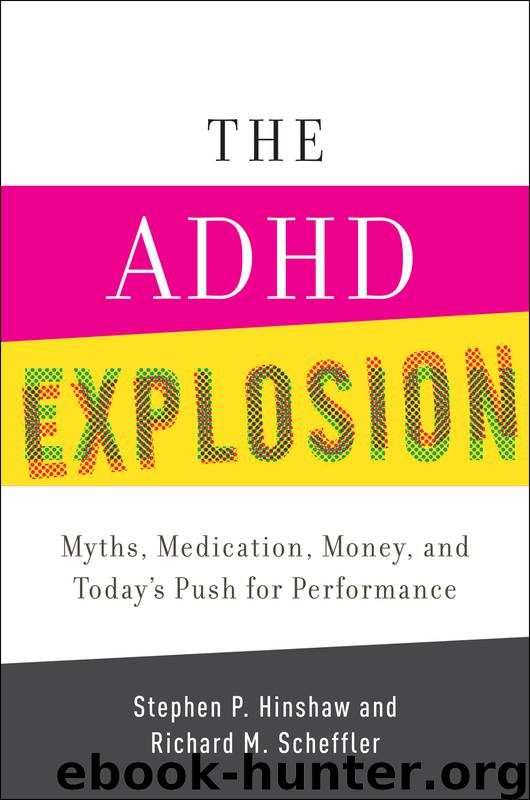The ADHD Explosion by Hinshaw Stephen P. Scheffler Richard M

Author:Hinshaw, Stephen P., Scheffler, Richard M.
Language: eng
Format: epub
Publisher: Oxford University Press, USA
Published: 2014-05-31T16:00:00+00:00
Treatment and Services for ADHD Around the World
Our research team published an article in the journal Health Affairs in 2007, where we examined global trends in medication use and medication costs for ADHD medicines from 1993 to 2003. A major finding was that the dominance of the United States in the world market for such medicines diminished across that time span. Indeed, by 2003, fully 55 nations had crossed the threshold to being considered “ADHD medication users,” up from 31 in 1993. Even more striking was that although overall global use of these pills tripled from 1993 to 2003, global spending went up by a factor of nine, even adjusting for inflation. The reason is that, in 2000 and beyond, the United States quickly adopted the newer, patented, and far more expensive long-acting forms of these pills. The rest of the world began to follow suit, with costs soaring higher than usage per se.15
Since that time, the global market has continued to expand. In 2000, for example, the United States accounted for 86% of the total international volume of ADHD medication, but by 2010 the percentage had dropped to 75%. Thus, over a quarter of all ADHD medications are now used outside the United States. From a different angle, between 2000 and 2010, the United States increased the volume of ADHD medicines it used by 32%, but the rest of the world increased their usage by 165%. ADHD medicine use is rising over five times faster around the world than here.16
In terms of costs, the United States increased its sales dollars of ADHD medications more than nine-fold from 2000 through 2010, but the rest of the world increased its spending 18-fold—double the American rate. From a somewhat different angle, the United States accounted for 93% of all dollars spent on ADHD medications in 2000, but that amount dropped to 88% by 2010. Certainly, the United States still dominates in terms of sales dollars—because of the high concentration of patented, long-acting formulations sold here, which cost far more than generics—but the rest of the world is catching up.17
Importantly, our research team also found that the wealth of a given country, as measured by its GDP, was a good predictor of how much ADHD medication it used. Not surprisingly, nations with more financial resources tend to use more medication for ADHD. Yet certain countries—namely, the United States, Canada, and Australia—use more medication than would be predicted by their national income. A number of European countries, by contrast, use lower amounts of medication than would be predicted by their GDP. We noted above the historical reasons for low rates of diagnosis and medication in the United Kingdom. As other examples, strict government regulations of prescriptions in France and Sweden might help explain the relatively low use of ADHD medications in those countries.18
In short, economic and regulatory policies clearly make a difference with respect to ADHD medication use around the globe. Other potential explanations include historical, political, and cultural values placed on academic achievement, as well as the beliefs and values of the education system.
Download
This site does not store any files on its server. We only index and link to content provided by other sites. Please contact the content providers to delete copyright contents if any and email us, we'll remove relevant links or contents immediately.
The Art of Thinking Clearly by Rolf Dobelli(10209)
The 5 Love Languages: The Secret to Love That Lasts by Gary Chapman(9584)
Mindhunter: Inside the FBI's Elite Serial Crime Unit by John E. Douglas & Mark Olshaker(9186)
Becoming Supernatural by Dr. Joe Dispenza(8119)
Nudge - Improving Decisions about Health, Wealth, and Happiness by Thaler Sunstein(7612)
The Road Less Traveled by M. Scott Peck(7522)
Enlightenment Now: The Case for Reason, Science, Humanism, and Progress by Steven Pinker(7227)
Mastermind: How to Think Like Sherlock Holmes by Maria Konnikova(7221)
Win Bigly by Scott Adams(7094)
The Way of Zen by Alan W. Watts(6503)
Factfulness: Ten Reasons We're Wrong About the World – and Why Things Are Better Than You Think by Hans Rosling(4691)
The State of Affairs by Esther Perel(4634)
Gerald's Game by Stephen King(4570)
Man's Search for Meaning by Viktor Frankl(4418)
The Confidence Code by Katty Kay(4187)
Thinking in Bets by Annie Duke(4152)
The Healing Self by Deepak Chopra(3473)
Hidden Persuasion: 33 psychological influence techniques in advertising by Marc Andrews & Matthijs van Leeuwen & Rick van Baaren(3472)
The Worm at the Core by Sheldon Solomon(3430)
